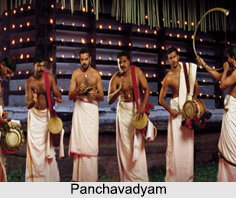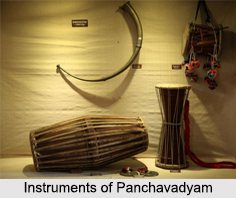 An orchestra of five instruments, Panchavadyam is a percussion art form that has graced almost all the major traditional festivals of the state of Kerala. The orchestra includes four percussion instruments namely timila, maddalam, ilathalam and idakka and a wind instrument, kombu. There are some institutes where the formal training of Panchavadyam is given. It includes Kerala Kalamandalam and Kshetra Kalapeetham in Vaikom.
An orchestra of five instruments, Panchavadyam is a percussion art form that has graced almost all the major traditional festivals of the state of Kerala. The orchestra includes four percussion instruments namely timila, maddalam, ilathalam and idakka and a wind instrument, kombu. There are some institutes where the formal training of Panchavadyam is given. It includes Kerala Kalamandalam and Kshetra Kalapeetham in Vaikom.
History of Panchavadyam
There are copper plates and rock inscriptions dating back from the 9th century CE that have mentions of Panchavadyam but most historians are of the opinion that the ensemble of instruments are most likely to be different from what it is today. Panchavadyam was formulated in the first half of the 20th century in central Kerala and has since enthralled audiences across the state and beyond.
Panchavadyam was the creation of late maddalam artistes Venkichan Swami and his disciple Madhava Warrier in alliance with late timila masters Annamanada Achutha Marar and Chengamanad Sekhara Kurup and Master Pattirath Sankara Marar.
Ensemble of Panchavadyam
The performance of Panchavadyam is a musical delight and there is no limit to the number of performers but a certain calculation is done for the number of instruments being played. For a short Panchavadyam, a single idakka may be played but for a large Panchavadyam, two idakkas are to be played. Discussed elaborately below are orchestra of instruments in Panchavadyam:
Timila: The timila is an hour glass shaped percussion instrument and is made of polished jackwood. The drumheads of the timila are made out of calfskin and are held together by leather braces which are also twined around the waist of the drum. A Panchavadyam performance begins with Timila Pattu and ends with the Timila Idachal thus making timila a very important component of the traditional Kerala percussion ensemble. It is also a major percussion instrument used in sree- bali, sree- bhootha- bali and related temple rites.
 Maddalam: Made out of the wood of the jackfruit tree, a maddalam is a drum that has two sides for playing, which is made out of leather. There are different kinds of sounds on each side. It is tied round the waist for playing and kept in horizontal position and played with both hands. Maddalam is not only a vital instrument in Panchavadyam but also in other percussion ensembles like Keli and Kathakali orchestra.
Maddalam: Made out of the wood of the jackfruit tree, a maddalam is a drum that has two sides for playing, which is made out of leather. There are different kinds of sounds on each side. It is tied round the waist for playing and kept in horizontal position and played with both hands. Maddalam is not only a vital instrument in Panchavadyam but also in other percussion ensembles like Keli and Kathakali orchestra.
Ilathalam: The ilathalam is a metallic musical instrument which resembles a miniature pair of cymbals and is completely made out of bronze with two pieces in it. The instrument is played by keeping one part of the cymbal in left hand banging the other cymbal to the one in left hand.
Idakka: Similar to the Pan Indian damaru, which is the instrument of Lord Shiva, an idakka is an hour glass shaped drum. Unlike the damaru, it is played with a stick and pitch may be bent by squeezing the lacing in the middle. The idakka is slung over the left shoulder and the right side of the instrument is gently beaten with a thin curve-ended stick.
Kombu: The only wind instrument in Panchavadyam, a kombu is like a long horn and is one of the few instrumental temple art forms in which the melody instruments dominate. The kombu is regarded as a rhythm instrument by the players and can produce only three notes. Recent research has revealed that kombu was used in ancient Ireland and is believed to have come to South India almost 2000 years ago.
Performance of Panchavadyam
Panchavadyam is characterized by a pyramid-like rhythmic structure. Its tempo increases slowly that is coupled with a decrease in the number of beats in cycles proportionately. In panchavadyam several instruments are used. It permits a lot of improvisation while filling up the rhythmic beats on the first three instruments.
Panchavadyam is based on the 14- beat adanta thaalam. However, it sticks to the pattern of the eight-beat chempata thaalam. It lasts for around 2 hours and has several phrases where each set of the instruments complement the others in a harmonious manner. It has artistes who line up in an oval shape facing each other. It gains pace in the early stages itself.
It is anchored and led by the timila artist at the centre of his band of instrumentalists, behind who stand the ilathalam players. The maddalam players stand opposite to them in a row and behind them stand the kompu players. The two Idakka players stand on both sides of the aisle separating the timila and maddalam line-up. Around sixty artistes would be there if there is a major panchavadyam.
It is a temple art though it has come out of its grounds. As now, it is performed during non-religious occasions like cultural pageantry and welcome of notable dignitaries.
Venues for Performing Panchavadyam
In some festivals like Trissur Pooram, Kaladi Panchavadyam ulsavam, Machattu Thiruvanikkavu vela, Nenmara-Vallangi vela, Vayilliamkunnu Pooram, Pariyanampatta pooram, Chinakathoor pooram, Varavoor Palakkal Karthika vela, Tirumandhamkunnu pooram purappadu, Tripunithura Sree Poornathrayeesa Aarattu, Tripunithura Thamaramkulangara Makaravilakku, Thiruvona Mahotsavam and Cherpulassery Ayyappan Kavu ulsavam panchavadyam is performed. Even in temples like Chottanikkara, Odakkali, Vaikom, Ambalapuzha, Perumbavur, Pazhur, Ramamangalam, Nayathodu, Chengamanad, Chennamangalam, Irinjalakuda, Thiruvillwamala, Pallassena, Pallavoor this is performed.




















